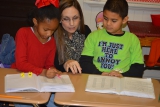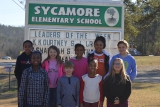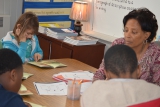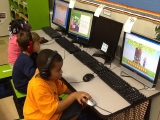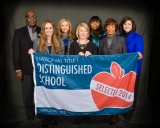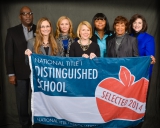-
Category 2
Selected in 2014
-
Grades: k - 4
School Setting: rural
Town Population: 599
Student Enrollment: 210
Student Demographics:
Black/African American: 49%
Teacher/Student Ratio: 1:18
White/Caucasian: 48%
Hispanic: 1%
Hawaiian/Pacific Islander: 0%
Asian: 0%
Native American: 0%
Other: 2%
% Reduced Lunch: 85%
% ELL Learners: 0%
Founded: 1909 -
PRINCIPAL:
Audrey Chatman -
CONTACT:
18101 Alabama Highway 21
Sycamore, AL 35149
256-315-5450
achatman@tcboe.org
Sycamore School
Sycamore, AL
The unique student centered nature of Sycamore Elementary focuses on the whole child. Students benefit greatly from the partnerships, initiatives and strong academic culture that are provided at our school. The size of our school contributes to a family oriented atmosphere in which all staff takes ownership for each child. One of the most significant changes that we have taken to improve our school culture is keeping "ONE FOCUS". ONE FOCUS is an acronym that means "Ownership Not Excuses" as we "Foster Our Children's Unique Skill Sets". We as a staff work together to find solutions to meet our students academic needs. This has been accomplished through incorporating cross grade level meetings, setting goals for individual students, and creating partnerships with outside agencies.
- Describe specific programs in place to ensure that families are involved in the success of your school and students.
- A critical component of our 21st Century Learning Program is parent involvement. Parent workshops are offered which include weather safety and STEM activities. Parents are invited to see students showcase their work and learning from the After School Program. Wellness Academics and You(WAY) provides parents the opportunity to learn more about gardening and physical activities that promote a healthier lifestyle. WAY specialists are a part of our Family Reading Night and share healthy recipes and various physical exercises that parents and students can do together. One of our goals for continuous improvement has been to increase parental involvement. Our school offers a variety of workshops throughout the year for parents in the areas of Math, Reading, writing, and technology.
- Describe the most successful activity your school has initiated to strengthen ties to your community.
- Many students at Sycamore live at or below the poverty line. This reality often affects their physical appearance and their mental motivation. With this in mind, we have developed partnerships with Food Solutions, Wellness Academics and You (WAY), and Getting Involved by Volunteering for Education (GIVE). Food Solutions, a non-profit organization comprised of community leaders and churches, provides food bags to a large percentage of our students each Friday afternoon. WAY is a program funded through various grants and focuses on the physical well-being of our students and their families. WAY encourages parental participation in gardening, physical activities, and creating healthy recipes. Through our partnership with WAY our school obtained four raised garden beds and an indoor tower garden. GIVE is our local churches and businesses and they provide our students with school supplies, coats, toys, and clothes.
- Describe your philosophy of school change or improvement.
- It is the vision of our school that "We will provide a positive, nurturing educational environment in which students experience success through quality child centered instruction." This reflects our philosophy that "it takes a village to raise a child". School change has happened at Sycamore because of this village concept. We all believe that our students can perform with high academic success. It is in this village concept that we take ownership not excuses for our students' performance. This belief system has led to our school being awarded the Alabama State Board of Education Torchbearer Award for two consecutive years (2012-2013 and 2013-2014).
- What are your school’s top two goals for the next year?
- Our school's top two goals for the next year are: 1.) To continue to improve student learning in the areas of reading and math and 2.) To continue to increase parental involvement. Our plans to improve student learning in the areas of reading and math will be augmented with our implementation of one to one devices. Each student will have access to the own personal iPad for the upcoming year. The increase of parental involvement will be assisted through our strengthening relationships with current partners and including a parental component in our PBL units.
- What is the single most important factor in the success of your school that others could replicate?
- Our focus on the "whole child". We have put in place several components to ensure that students physical, emotional and academic needs are met. Community partnerships have been established with Food Solutions, Wellness Academics and You(WAY), and Getting Involved By Volunteering for Education (GIVE) to ensure that students physical needs are met. Our implementation of "The Leader In Me" ensures that students are given the emotional tools necessary to take charge of their behavior and academics. Our school's ONE FOCUS "Ownership Not Excuses" "Fostering Our Children's Unique Skill Sets" is critical in targeting the specific individualized needs of all students. This minute focus is accomplished through student and teacher data notebooks, small group instruction, individualized learning conferences, individualized learning targets, and goal setting using various data sources.
- Describe the program or initiative that has had the greatest positive effect on student achievement, including closing achievement or opportunity gaps, if applicable.
- The positive gains in student achievement can't be atttributed to any particular program or initiative but in a relentless focus on the specific individualized needs of each student. The programs and initiatives incorporated all reinforce our individualized focus. For example, students at our school are discovering the "leader within" as we implement Stephen Covey's "The Leader In Me". Through daily practices of "The Leader In Me", students have learned to take ownership of their choices and their learning. Students set academic and personal goals as part of our leadership focus. Our school is also a 21st Century Community Learning Center. All students are given the option to participate in the 21st Century Learning After School Program. This program is teacher led and supports students academically with remediation and enrichment of skills. The 21st Century After School Program is essential to our individualizing and providing students extra support to make academic gains.
- Explain how Title I funds are used to support your improvement efforts.
- Title I Funds are utilized in direct correlation with the goals that our school has set for continuous improvement. Each year cultural and academic goals are determined based on data, surveys, and evaluations. These goals are collaboratively determined by teachers, parents, community partners, support staff, and administration. The expenditure of Title I funds are aligned with the resources needed to augment weaknesses.
- Identify the critical professional development activities you use to improve teaching and student learning.
- Our school utilizes job embedded professional development bi-weekly for each grade level. Our professional development is based on weaknesses determined by our student academic data, teacher surveys, and teacher evaluations. We have monthly technology professional learning groups with a specialist from the University of Montevallo in which we are learning about various technology tools. All staff members have been trained in Project Based Learning by our district's Coordinator of Instructional Technology. This training has assisted our teachers in planning and implementing multiple PBL's throughour the year. All staff members have been trained in AMSTI math and receive support from AMSTI specialists. A school team participates in Powerful Conversations which is provided by the Alabama Best Practice Center. The school team then trains the remainiing staff members.
- Describe how data is used to improve student achievement and inform decision making.
- Data is utilized from the school-wide level to each individual classroom. School-wide data is monitored and housed in a data notebook. Our halls showcase school-wide goals and data monitoring boards while individual classrooms reflect class goals. All classroom teachers have data notebooks that include individual classroom assessments, computerized common assessments, checklists, and anecdotal notes. From these various data sources, small groups and student goals are formed. Teachers confer with students about students' strengths and weaknesses to determine individual student goals. Goals, charts and aimlines are utilized to monitor these goals. Each student has an individual leadership/data notebook which contains their goals, data sources used to monitor their goals, recognition awards for goal accomplishments, and tools/resources needed to reach these goals. Data meetings are conducted monthly will all grade levels.
- Describe your school culture and explain changes you’ve taken to improve it.
- The unique student centered nature of Sycamore Elementary focuses on the whole child. Students benefit greatly from the partnerships, initiatives and strong academic culture that are provided at our school. The size of our school contributes to a family oriented atmosphere in which all staff takes ownership for each child. One of the most significant changes that we have taken to improve our school culture is keeping "ONE FOCUS". ONE FOCUS is an acronym that means "Ownership Not Excuses" as we "Foster Our Children's Unique Skill Sets". We as a staff work together to find solutions to meet our students academic needs. This has been accomplished through incorporating cross grade level meetings, setting goals for individual students, and creating partnerships with outside agencies.
Stats
-
Category 2
Selected in 2014
-
Grades: k - 4
School Setting: rural
Town Population: 599
Student Enrollment: 210
Student Demographics:
Black/African American: 49%
Teacher/Student Ratio: 1:18
White/Caucasian: 48%
Hispanic: 1%
Hawaiian/Pacific Islander: 0%
Asian: 0%
Native American: 0%
Other: 2%
% Reduced Lunch: 85%
% ELL Learners: 0%
Founded: 1909 -
PRINCIPAL:
Audrey Chatman -
CONTACT:
18101 Alabama Highway 21
Sycamore, AL 35149
256-315-5450
achatman@tcboe.org


